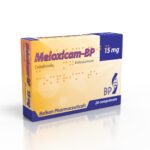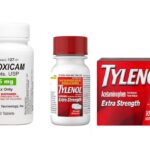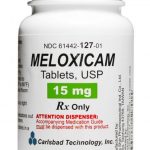Is Meloxicam A Strong Painkiller?

What are painkillers?
Painkillers are medicines that are used to treat pain. There are a large number of painkillers available and they all come in various different brand names. They can be taken:
- By mouth as liquids, tablets, or capsules.
- By injection.
- Via the back passage (rectum) as suppositories.
Some painkillers are also available as creams, ointments, or patches.
Even though there are a large number of painkillers available, there are only three main types (paracetamol, NSAIDs, and compound painkillers) each works in a different way.
The type of medicines that you need to treat your pain depend on what type of pain you have. For pain associated with inflammation, such as back pain or headaches, paracetamol, and anti-inflammatory painkillers work best. If the pain is caused by sensitive or damaged nerves, as is the case with shingles or sciatica, it’s usually treated with tablets that change the way the central nervous system works.
The aim of taking medication is to improve your quality of life. All painkillers have potential side effects, so you need to weigh up the advantages of taking them against the disadvantages.
What is meloxicam?
Meloxicam is a prescription drug. It comes in three forms: an oral tablet, an injection, and an oral capsule. Meloxicam oral tablet is available as the brand-name drug Mobic.
Meloxicam oral tablet is also available as a generic drug. Generic drugs usually cost less than the brand-name version. In some cases, they may not be available in all strengths or forms as the brand-name drug.
Why it’s used
Meloxicam decreases inflammation and pain. It’s approved to treat:
• osteoarthritis
• rheumatoid arthritis
• juvenile idiopathic arthritis (JIA) in children ages 2 years and older.
How it works
Meloxicam belongs to a class of drugs called nonsteroidal anti-inflammatory drugs (NSAIDs). NSAIDs help reduce pain, inflammation, and fever.
It isn’t known how this medication works to decrease pain. It may help reduce swelling by lowering levels of prostaglandin, a hormone-like substance that usually causes inflammation.
How should meloxicam be used?
Meloxicam comes as a tablet and suspension (liquid) to take by mouth. It is usually taken once a day with or without food. Take meloxicam at the same time every day.
Typical dosing for meloxicam (Mobic)
Tablets
Rheumatoid arthritis and osteoarthritis: Take 7.5 mg to 15 mg by mouth once a day. Do not take more than 15 mg a day.
Juvenile rheumatoid arthritis: Take 7.5 mg by mouth once a day. Do not take more than 7.5 mg a day.
Capsules
Rheumatoid arthritis and osteoarthritis: Take 5 mg to 10 mg by mouth once a day. Do not take more than 10 mg a day.
Follow the directions on your prescription label carefully, and ask your doctor or pharmacist to explain any part you do not understand. Take meloxicam exactly as directed. Do not take more or less of it or take it more often than prescribed by your doctor.
Shake the suspension well before each use to mix the medication evenly. The maximum recommended daily oral dose of meloxicam is 15 mg. Meloxicam may be taken without regard to the timing of meals.
Is meloxicam a strong painkiller?
Meloxicam is a strong painkiller and one of the longest-lasting non-steroidal anti-inflammatory drugs (NSAIDs) currently available, as it keeps working for 24 hours after taking it.
Meloxicam provides relief for much longer periods than most NSAIDs. Peak concentrations are reached within 2 hours (capsule) and 4 to 5 hours (tablets). Meloxicam appears to be recycled in the liver so another peak is reached in 8 hours (capsule) or 12-14 hours (tablet) after the initial dose.
It starts working within 30 minutes, but peaks in efficacy at four hours when taken by mouth. Its half-life is 15-20 hours, meaning it takes 15 hours to eliminate half of it from your body.
However, meloxicam can cause ulcers, bleeding, or holes in the stomach or intestine. These problems may develop at any time during treatment, may happen without warning signs or symptoms, and may cause death.
Is meloxicam 15 mg stronger than ibuprofen 800?
Yes, meloxicam is a stronger drug than ibuprofen. Although both ibuprofen and meloxicam are nonsteroidal anti-inflammatory drugs (NSAIDs), meloxicam is a long-acting drug that can relieve pain for up to 24 hours and it is not prescribed in combination with other drugs. Both drugs are available in prescription form but ibuprofen is also available in over-the-counter form.
Can I take 30 mg of meloxicam a day?
No, meloxicam doses of 22.5 mg and higher have been linked to an increased risk of serious GI events; thus, meloxicam should not be taken more than 15 mg per day.
Is meloxicam a muscle relaxer?
Meloxicam is NOT a muscle relaxer but a pain killer, that is sometimes used in combination with muscle relaxants for the treatment of conditions like acute nonspecific back pain (NSBP).
Muscle relaxants work by causing the muscles to become less tense or stiff, which in turn reduces pain and discomfort. They do this in different ways. Baclofen, diazepam, methocarbamol, and tizanidine act on the central nervous system (brain and spinal cord). Dantrolene works directly on the muscle.
What are the possible side effects of meloxicam?
Meloxicam may cause side effects. Tell your doctor if any of these symptoms are severe or do not go away:
• constipation
• diarrhea
• gas
• sore throat
Some side effects can be serious. If you experience any of the following symptoms, call your doctor immediately. Do not take any more meloxicam until you speak to your doctor:
• back pain
• blisters
• cloudy, discolored, or bloody urine
• difficult or painful urination
• difficulty breathing or swallowing
• fast heartbeat
• fever
• flu-like symptoms
• hives
• hoarseness
• itching
• lack of energy
• nausea
• pain in the right upper part of the stomach
• pale skin
• rash
• shortness of breath or difficulty breathing
• skin blisters or peeling
• swelling in the abdomen, ankles, feet, or legs
• swelling of the eyes, face, tongue, lips, or throat
• unexplained weight gain,
• yellowing of the skin or eyes
Meloxicam may cause other side effects. Call your doctor if you have any unusual problems while taking this medication.
If you experience a serious side effect, you or your doctor may send a report to the Food and Drug Administration’s (FDA) MedWatch Adverse Event Reporting program online (http://www.fda.gov/Safety/MedWatch) or by phone (1-800-332-1088).





